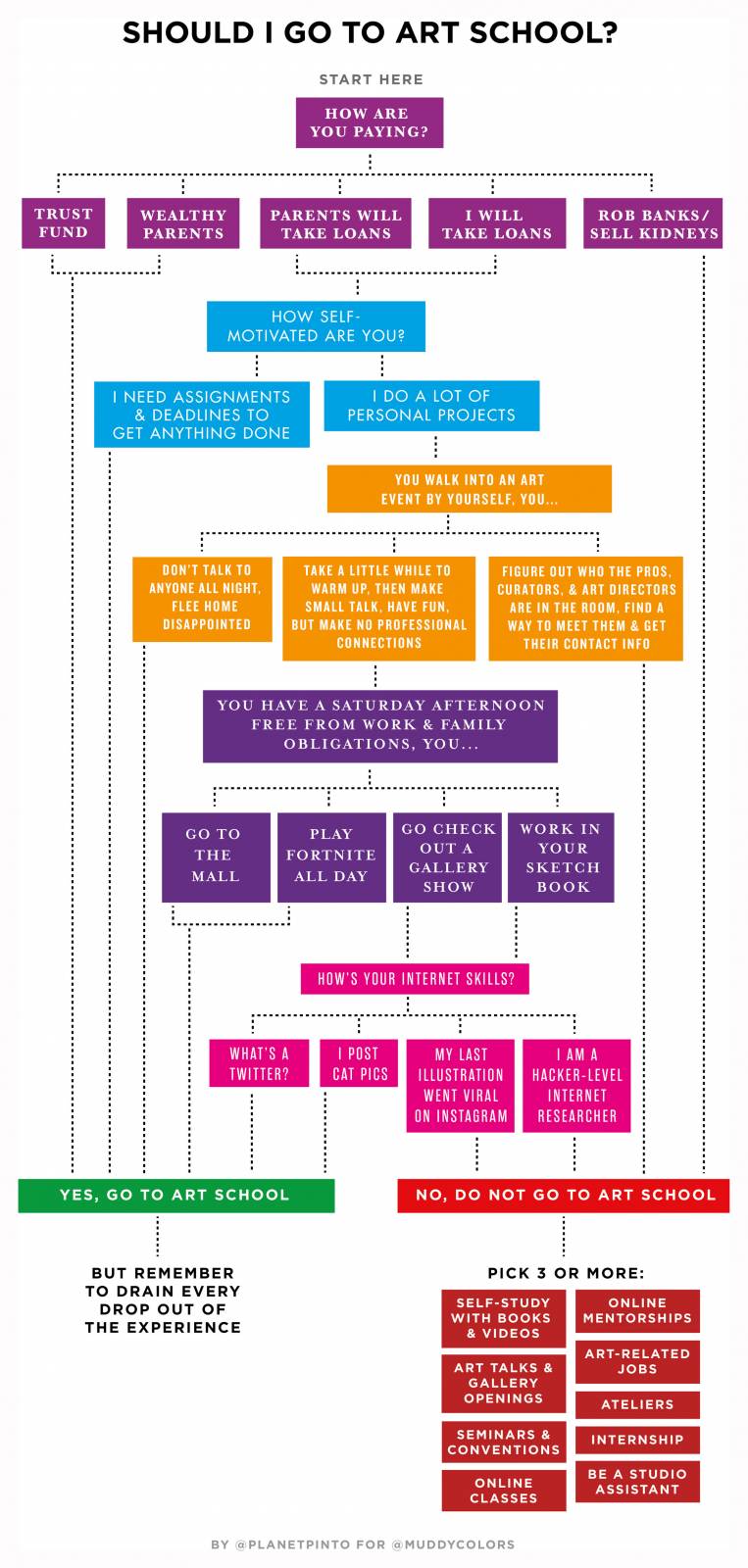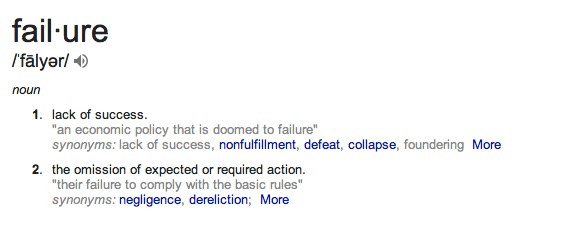The question of whether someone should go to art school or not is a smaller conversation in the bigger “Is Higher Education Worth the Cost” debate raging everywhere (especially in the US). Student debt can be crippling to someone starting out in any field, but it is often extra hard to bear as an artist because most artists will not come out of school able to pull in enough money to support themselves solely off their art. It takes time to develop your both your style and skills, and it takes time to work your way up the industry ladder in your chosen field. Most fields of Art also do not have the well-beaten path to a career that many other industries have (get an internship while in school, have a well-established tier of entry-level positions from which you can work your way up). Graphic Design/Advertising can, and sometimes animation can, but any of the fine arts and most of the freelance-based paths have a much more confusing road after graduation. Most graduates with a BFA will exit school and either not work in an art-related job or be convinced that they need to take on even more debt and go on to graduate school for an MFA.
This is not a new debate: Eric Fortune posted about this on Muddy Colors way back in 2010.
Very few art schools do a good job preparing you to have a career and teach little to no business. The best programs give you a Business Practices class in your senior year, usually only one semester. That’s barely enough time to learn how to set up an invoice properly—forget understanding self-promotion, professional etiquette, networking & negotiation skills, and contract terms. The lack of business preparation given to artists in school is exactly the reason Marc Scheff & I started Drawn + Drafted to circulate as much art biz info as possible.
However, Art as a career has one major advantage: you can succeed in many many fields of Art without an Art degree. In Art, your portfolio is king. Not only does the quality of your work supercede your degree — in many jobs no one will even look at your resumé. No Art Director hiring a freelance illustrator, photographer, or designer even looks to see what school you attended. At most we’ll look at a client list to see what professional experience you have, but I’ve literally never looked for a freelancer’s resumé. A fine art career may get launched by the gallery connections you make in school — but going to school is no guarantee of successful connections — and there are other ways to make them. Some in-house jobs (many in Graphic Design) do ask for a Bachelor’s degree as a requirement, but even so I know many ADs would overlook that if someone’s design portfolio and skills were convincing.
So Art School generally doesn’t teach you Art Business or how to build an Art Career. It doesn’t really help you find a job—unless one of your teachers hire you, which only happens in a program that staffs itself with active working professionals, but that’s not quite the same as job placement assistance. What CAN it do? It can definitely teach you technique. It forces you to continuously work (if you are a good student), which implies continuous improvement. It absolutely spoon-feeds you networking opportunities (through events, trips, guest lecturers, school gallery shows, etc.). And it forces you to interact with your teachers and peers.
So to sum all that up, Art School ideally gives you Technique and Connections. Can you get those without Art School?
In today’s day and age there are more opportunities than ever to get instruction on Technique outside of a traditional school setting. There have always been ateliers and mentorships and seminars in person, but the internet has made all of these things possible remotely. Many artists offer paid remote mentorships, either solo or through a collective program like SmArt School. There are literally thousands of recorded classes and demos (some amazing ones through this very blog) and podcasts and crowdcasts.
One caveat: please do research your mentorships before you begin them. An artist that offers paid mentorships should have current and/or former students that you can talk to about the mentor. Do your homework! Anyone can call themselves a coach or a mentor. Make sure that person has experience teaching as well as be sure they are teaching what you want to learn. Your mentor’s style does not have to be the same exact style as yours, but there should be some correlations in style, medium, industry, or philosophy. In other words make sure you’re not just picking someone famous, you’re picking someone that you want to learn something concrete from. Knowing that will help you narrow down mentorships.
And a portion of all that money you are saving by not going to school can be budgeted towards seminars like Illustration Master Class, conventions like Spectrum and IFCC, and trips to visit museums & cities where your chosen industry has hubs (NYC and London for publishing, LA for film & animation, Seattle & Portland for video games, etc.) Some conventions even livestream, like Trojan Horse is a Unicorn.
As far as Connections go, the internet helps here as well. Although meeting in person is nice, there are plenty of artists I have relationships with purely through social media. You can promote yourself, join important conversations about your industry, get your work seen by Art Directors and clients, ask questions, and even get feedback on your work online. And again, using some of the money you’d be spending on art school to fund trips to events to meet pros and Art Directors is a great investment.
So if you can get everything Art School provides through other ways, then why would anyone go to Art School?
Because it’s not easy to piece together an education on your own. Not everyone is self-motivated enough to follow through. And you have to be extremely outgoing (online and in person) to find and replace the connections that you won’t be getting automatically through school. I honestly don’t know if I would have had the career I’ve had if it wasn’t for going to traditional Art School for Design.
There is also a maturity aspect to this conversation — most teenagers are not self-disciplined enough or have enough life experience to keep themselves dedicated to a self-designed education. In the US at least it is expected that most middle class and upper class high school graduates will go to college automatically, even if they don’t know what field they want to go into. This is obviously not fair, as all families/students can’t afford the opportunity to pay that much money to figure out what they want to do (or can afford to go even if they DO know exactly what field you wish to go into). Honestly I don’t think students that can afford it should automatically go straight into college if they don’t know what they want to study. I certainly was forced to pick a direction way before I was ready. Why not work a year, or volunteer for a year in a program like AmeriCorp or the Peace Corp? Go to a cheaper community college for a year, or two. Get a job, earn some money, try living on your own. Most 18 year olds are more interested in getting out of their parents’ house than going to class — maybe it should be more socially acceptable to let them do that for a little while until they have a taste of the real world and a better handle on their career interests. I started off as pre-med, then switched to art. Maybe a year or two between high school and college would have helped me have a better idea of what I wanted to do (and saved two years of pre-med tuition). I am lucky — my parents could manage to take loans and pay for my education. I saved money by commuting from home once I decided to transfer to the School of Visual Arts in NYC, but I was still incredibly privileged to not start off my adult life under thousands of dollars of student debt. Once I got to SVA, I worked my butt off convincing my teachers that I would make a fantastic assistant, and I worked as an intern for Perry Ellis, MTV, for a boutique design/illustration studio, and for St. Martin’s Press all before I graduated. (SVA Design is one of those programs that insists teachers be working professionals.)
It all comes down to 2 things: How much you/your family can afford, and how self-disciplined you are.
If you can set aside the money without going into crippling debt than absolutely go to Art School! But be aware of the privilege and make the most out of every opportunity. Make friends, enter shows, impress your teachers, go on trips, and take your assignments seriously. Your career doesn’t start when you graduate, your career starts as a freshman and your bosses are your teachers. Impress them, and opportunities follow.
However, if you don’t have the money for at least a large chunk of the cost, then look into other options. Maybe get a good community school education while you study art on the side. Maybe work a part time job and enroll in an atelier. If you can, work an art-related job as a studio assistant for a working artist or in an art supply store. Take online classes and find remote and in-person mentors. Work on your portfolio. Work on it more. Keep learning and keep challenging yourself. Travel to museums and professional events. Keep working on your portfolio. I am really starting to believe Art School is a luxury, not a necessity. It’s absolutely easier and more convenient to go, but I can’t condone people taking on a debt so large that it will often force them out of the career path that they took on the debt to study in the first place.
To help you figure out whether you should go to art school or not, here’s a handy (non-scientific) flow chart:








I went to a ‘traditional college’ that had a solid design program. The first two years we dealt mainly with traditional fine art skills and did little to nothing on computers. To be fair I was at the edge of computers being mainstream in the field and their computer lab wasn’t the best. I later went to another college that had a great computer lab but not so good fine art teaching (but that had no effect on me because I was basically there to brush up on and learn programs). Both schools were great at trying to get art students to realize the realities of deadlines.
The good thing about the 1st college was the critiques (which were sometimes brutal) and classroom settings for live instruction. That was the biggest growth factor for me because there was no comfort zone and it was very much a ‘competitive atmosphere’. I later went on to teach a college prep class in HS for nearly 10 years to give back what I found missing in the ‘macaroni art atmosphere’ of the high schools I had been associated with. We were able to get a lot of scholarships to high priced art schools. We focused on traditional art portfolios with computer design as an accent but with very real world projects. We also hammered ‘process’ as vital to developing work, helping the art minded to keep focus, and being able to talk to a client and to help let them have some insight so there is a flow of communication between the parties.
I always told the students to look at traditional 4-year schools that had great fine art programs (computers are just tools, computers can’t fix inability to draw and paint and more importantly to ‘see’, the more you can do the better chance you have of having a successful career, immediately seek out and befriend the hardest working students that have promise, try to take some business courses, learn all you can about EVERYTHING so that you have a bigger bucket to pull from, and like anything in life…you will get out of it what you put in to it)…After seeing the results and types of ‘online art courses’ from colleges I advised them to try their hardest to avoid these if it involved actual production of art. There was a lot of bad art and not a lot of engagement during critiques…it always seemed to be ‘let’s get this over with so I can get on with my day’ and not a lot of great communication.
From a practical sense (and speaking from experience as both an owner and employee and someone with some insight in dealing with recruiters) in the ‘traditional business world’….for right or wrong….many full-time/part time/not individual projects for hire design jobs use a college degree for a ‘filter’ to get your portfolio through the door for a review. I saw some really good and talented artists not get a look just because they lacked the sheepskin. The college isn’t super important, it was just looked at as ‘the person can fulfill obligations, complete a process and is trainable.” Then they would dig through the portfolios. The businesses viewed that as less of a risk even if at times they missed out on some gems.
Thank you for your experience. I agree about Design jobs and called those out specifically as the Art jobs that do usually have degree requirements. Again, I think with relevant experience and a great portfolio you can get around those —most ADs I know do not rely on HR depts to recruit artists for them because they don’t know what to look for, but it is true, it’s a little harder to get in the door.
Unfortunately I can’t agree with what you’re saying about online critique levels. I suspect your info may be a few years out of date. The software available for interactive learning and video meetings has come a really far way the last few years, allowing for demos, paintovers, full interaction with students, etc. I have sat in on many online mentorships and especially SmArt School classes and the critiques were the same level or better than anything I received in a top arts college. You have to do your homework, talk to people who have taken the classes, and see what they say. Any reputable program or mentor should be able to refer you to alums to talk to. if not, that’s a huge red flag.
Great article Lauren, and for Brine, I can testify how good the SmArtschool setting really is. It has helped me tremendously in moving forward.
I definitely think the financial considerations of attending art school need to be taken very seriously. It could be a big mistake to recklessly go into debt pursuing an art education. That said, I think a good art school offers considerably more than just technique and connections. A good art school can help artists learn how to THINK about their art, something that goes well beyond technique. At a university (and perhaps elsewhere?), it can offer a background in art history and the opportunity to take business classes that may not be available at a school strictly for art. Art school offers the “hands on” opportunity to learn from a variety of teachers and consequently, to encounter a range of viewpoints, some of which may be quite different from your own (or those you would seek out while pursuing self-education). The opportunity to learn and interact with other students on a day-to-day basis is invaluable too and goes well beyond making business connections. A class critique can be a humbling and useful experience!
My point: cost is a significant factor but art school can definitely offer more than just technique and connections. It can and should be a place where a student is constantly exposed to ideas and possibilities. That can be extraordinarily valuable to an artist’s growth and development and even though the ability to interact online has come a long way, I think it’s hard to beat the value in day-to-day, in-person interaction.
Thank you, Lauren. It’s great to hear this from the hiring side of the equation. Your approach would also be a good tool for answering “Should I STAY in art school?”
As an art-school dropout,
Who became an illustrator,
Then a graphic designer;
Who went back to school in his late 30s,
Got a BS in industrial design and a MS in design,
And became an industrial designer;
Who’s now a full-time drawing and digital graphics instructor in a university,
And is moving back into illustration…
…I don’t regret dropping out of art school at all. My partial art education was useful. In fact, it started my career, but I’m glad I left before I went bankrupt.
Later, when I went back to school, I was much better equipped to “drain every drop out of the experience”. My finances were stable(ish), and my professional experience helped me figure out what I wanted to learn. I was able to focus on the skills I wanted to develop and be reasonably confident that my education was building my career.
Forgot to add this:
When I dropped out of art school, it felt like the end of the world. In retrospect, it was a good thing. But at the time, I thought my art career was over. Having a clear reason for dropping out, and a solid plan for improving my skills on my own would have saved me a ton of anxiety.
I went to community college for two years and transferred to a state college, which saved me quite a bit of money. One benefit of school I would like to point out is being able to have access to studio classes with specialized equipment such as printmaking, metalsmithing and fibers. I know many graphic design majors who feel that getting away from the computer to do some hands-on art has helped improve their graphic design thought process. Having to take a variety of art history classes is fun as well.
Great article